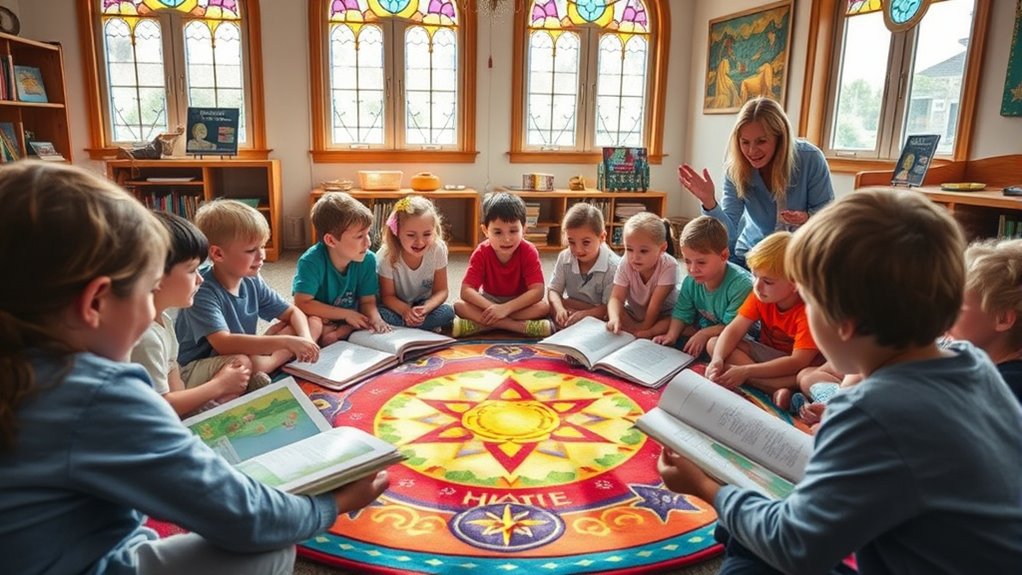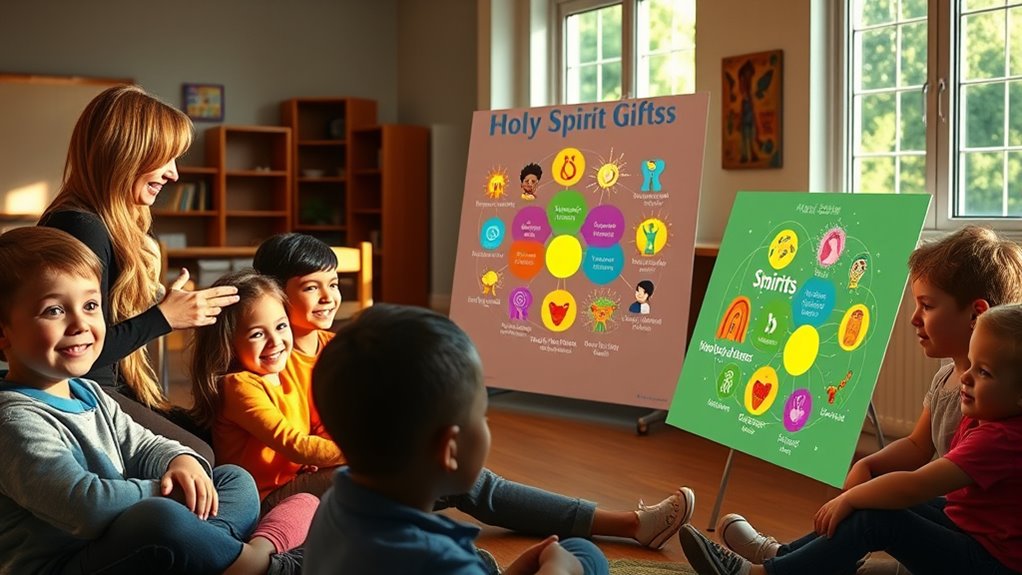To teach kids about the Holy Spirit and spiritual gifts, use simple Bible stories, visual aids, and creative activities that make these concepts relatable and fun. Help them recognize their talents through crafts, games, and prayer, encouraging quiet listening to God’s voice. Show how gifts like kindness and wisdom can help others daily. If you explore these ideas further, you’ll find effective ways to inspire children to grow in faith and serve with confidence.
Key Takeaways
- Use engaging Bible stories and visual aids to illustrate the Holy Spirit’s presence and spiritual gifts.
- Incorporate creative activities like crafts, collages, and games to help children discover and express their gifts.
- Teach prayerful listening and reflection to help kids recognize how the Holy Spirit guides their talents.
- Encourage awareness of personal strengths and natural abilities as signs of spiritual gifts from God.
- Reinforce that each child’s unique gifts are part of God’s plan to serve others and deepen faith.
Understanding the Holy Spirit in Simple Terms

The Holy Spirit is a special part of God that helps and guides us every day. Think of the Holy Spirit as a gentle friend who’s always with you, offering divine guidance when you need it. The Holy Spirit is not a person you can see, but you can feel its presence in your heart. It helps you make good choices, gives you peace during difficult times, and helps you understand God’s love. When you pray or read the Bible, the Holy Spirit can help you understand what God is telling you. Remember, having the Holy Spirit with you means you’re never alone. It’s like having a special helper who guides your steps and keeps you connected to God’s love all the time. Recognizing the divine guidance of the Holy Spirit can help you grow in faith and trust in God’s plan for your life. Developing an awareness of this spiritual presence can deepen your relationship with God and strengthen your faith journey. Being aware of the Holy Spirit’s energetic connection can also amplify the feelings of comfort and reassurance you experience.
Sharing Bible Stories That Highlight the Holy Spirit

Sharing stories from the Bible can help kids see how the Holy Spirit works in real life. These stories often include Holy Spirit symbolism, like wind or fire, to show His powerful presence. For example, in Acts 2, the Holy Spirit appears as tongues of fire during Pentecost, symbolizing purification and empowerment. Biblical gift stories, such as the gifting of the apostles with speaking in different languages, demonstrate how the Holy Spirit equips believers for service. By sharing these stories, you help kids understand that the Holy Spirit is active today, guiding and strengthening us. Use these stories to illustrate how the Spirit’s gifts can be seen in everyday life, making the concept more relatable and meaningful for young learners.
Using Visual Aids to Explain Spiritual Gifts

Using visual aids can make spiritual gifts easier for kids to understand and remember. You might use colorful gift charts, interactive activities, or props to bring stories to life. These tools help children connect with the Holy Spirit’s gifts in a fun and meaningful way. Incorporating visual aids that are engaging and age-appropriate can enhance learning and retention of these spiritual concepts.
Colorful Gift Charts
Colorful gift charts serve as a fun and effective way to help kids understand spiritual gifts. These charts use vibrant colors and clear labels to make complex concepts simple and engaging. As a form of visual learning, they help children see the different gifts at a glance, making it easier to remember and relate to them. When you introduce a colorful gift chart, kids can quickly identify each spiritual gift and understand how they fit into the bigger picture of faith and service. Using visual aids like these keeps their attention focused and encourages interaction. Plus, the bright visuals make learning about the Holy Spirit’s gifts enjoyable, helping children connect personally with the spiritual truths you’re teaching. Incorporating visual aids like these is also supported by educational research, which shows they enhance understanding and retention. Additionally, incorporating visual tools into teaching can cater to diverse learning styles and make spiritual lessons more memorable. Employing engaging visuals can also improve comprehension, making abstract ideas more tangible for young learners. Incorporating these colorful and interactive charts can foster a deeper appreciation of the spiritual gifts, encouraging children to discover their own unique talents and roles within faith communities.
Interactive Visual Activities
Interactive visual activities bring spiritual gifts to life by engaging children directly in hands-on learning experiences. Using visual aids, you can help kids connect Bible verses with real-world examples of spiritual gifts, making abstract concepts more concrete. For instance, you might create charts or diagrams that show different gifts like kindness, wisdom, or faith, and then relate them to specific Bible verses. Incorporate prayer practices by encouraging children to pray for each gift, helping them internalize its importance. These activities foster active participation, making the learning process memorable. By combining visual aids with prayer practices, you help children understand that spiritual gifts are gifts from God meant to be shared through love and service. Understanding how visual aids can enhance their learning experiences can further deepen their connection to faith. Additionally, incorporating interactive learning methods can make the lessons more engaging and memorable for children. Recognizing the significance of spiritual gifts in their faith journey can inspire children to embrace their unique talents and serve others more confidently, especially when they see how diverse designs of teaching tools can cater to different learning styles.
Storytelling With Props
Storytelling with props brings spiritual gifts to life by making abstract ideas tangible and memorable. You can craft stories that highlight each gift, using visual aids like puppets to engage kids’ imaginations. For example, use a puppet to personify the Holy Spirit or specific gifts like wisdom or kindness. Using puppets helps children see these qualities in action, making the lessons stick. Incorporate props that symbolize different gifts, encouraging kids to participate in storytelling. This hands-on approach helps kids understand the purpose and importance of spiritual gifts in a fun, relatable way. By using puppets and visual aids, you turn complex concepts into simple, memorable lessons that resonate with children, fostering a deeper understanding of the Holy Spirit’s work in their lives. Additionally, demonstrating the influence of spiritual gifts can mirror the significant asset division seen in Native communities, helping children grasp the importance of these divine qualities in their daily lives. Incorporating educational techniques, such as visual storytelling, enhances engagement and retention of these spiritual lessons. Using props and storytelling can also mirror the hours concept, emphasizing that spiritual growth and understanding develop over time through engaging and consistent lessons.
Creating Fun Activities to Discover Personal Gifts

You can help kids discover their spiritual gifts through fun activities like gift scavenger hunts or creating gift collages. These hands-on experiences make learning about the Holy Spirit engaging and memorable. Incorporating spirit-inspired art also encourages kids to express their gifts creatively. Using interactive and versatile methods can further enhance their understanding of how the Holy Spirit provides different gifts for each individual.
Gift Scavenger Hunts
Gift scavenger hunts are a lively and engaging way to help kids discover their unique spiritual gifts. As they search for hidden clues, they learn to recognize symbolic gestures that point to their strengths. Incorporate gift symbolism by using items that represent different gifts, like a small cross for faith or a heart for compassion. This activity transforms abstract concepts into tangible experiences, making spiritual gifts memorable and meaningful. Use the table below to help kids understand the deeper significance of their discoveries:
| Symbolic Gesture | Gift Meaning |
|---|---|
| Cross | Faith |
| Heart | Love and Compassion |
| Light | Wisdom |
| Hands | Service |
| Voice | Encouragement |
This approach makes discovering gifts fun and spiritually enriching. Recognizing and understanding spiritual gifts in everyday life can foster a deeper connection to faith and community. Engaging children in such interactive activities helps them see how their gifts can be used to serve others and grow in faith. Developing an awareness of astrological charts can also deepen their understanding of individual traits and how they relate to their gifts. Furthermore, explaining how to identify personal gifts can encourage children to reflect on their unique talents and strengths. Additionally, exploring the various ways to serve allows children to see the practical application of their gifts in daily life.
Creative Gift Collages
Creating a gift collage is a fun and meaningful way for kids to discover their personal spiritual gifts. Provide a large sheet of paper or poster board, along with magazines, drawings, and craft supplies. Encourage kids to think about their unique talents and how the Holy Spirit might be guiding them. They can cut out images, words, or symbols that represent their gifts and glue them onto a gift box or central image. This process sparks divine inspiration, helping children visually see their strengths and how they can serve others. As they create, discuss what each element means and how it relates to their spiritual journey. The finished collage becomes a personal reminder of their gifts and God’s plan for their life. Incorporating spiritual gifts into the activity helps reinforce their significance and encourages kids to embrace their unique callings.
Spirit-Inspired Art
Have you ever thought about how art can help kids discover their spiritual gifts? Spirit-inspired art is a powerful way to engage children in creative worship and explore their unique talents. By encouraging kids to express their faith visually, they can better understand how the Holy Spirit works in their lives. You can facilitate activities like painting, drawing, or crafting that focus on themes of love, service, or gratitude. These projects help kids recognize their gifts and see their connection to God’s work. To make it fun, try these ideas:
- Creating a collaborative mural depicting spiritual gifts
- Making personal prayer journals with doodles and symbols
- Designing faith-inspired collages
- Painting images that represent their spiritual strengths
- Crafting symbols that reflect the fruits of the Spirit
Encouraging Prayer and Listening for God’s Voice

Encouraging children to pray and listen for God’s voice helps them develop a personal relationship with the Holy Spirit. Teach kids that prayerful listening isn’t just about talking to God but also about quieting their minds to hear His guidance. You can help them practice voice recognition by asking simple questions and encouraging them to listen carefully to their inner thoughts or feelings. Remind children that God’s voice can come as a gentle whisper or a peaceful feeling. Create a safe space where they feel comfortable sharing their thoughts and listening without distraction. Over time, they’ll learn to recognize God’s voice and trust His gentle nudges, strengthening their connection with the Holy Spirit through active, prayerful listening.
Exploring Different Types of Spiritual Gifts

Understanding the different types of spiritual gifts helps you see how God works through each person uniquely. Recognizing these different gift types makes it easier to see where your child’s talents may fit into God’s plan. Some common gifts include wisdom, faith, healing, prophecy, and teaching. By focusing on gift identification, you help your child understand their strengths and how they can serve others. Remember, each gift plays a essential role in the church community. Here are some examples:
- Wisdom and knowledge
- Faith and trust in God
- Healing and miracles
- Prophecy and speaking God’s truth
- Serving and helping others
Knowing these gift types helps your child appreciate their spiritual abilities and encourages them to grow in their faith journey.
Helping Kids Recognize Their Unique Talents

Helping your child recognize their unique talents is an important step in nurturing their faith and confidence. Through talent discovery, you help them see the gifts God has given them. Encourage your child to try new activities and observe what excites or energizes them. Praise their efforts and progress, emphasizing that these talents are special gifts meant to be used for good. Talk about how the Holy Spirit helps us identify our strengths and guides us in gift recognition. By supporting their exploration, you help them understand that their talents are part of God’s plan. This awareness builds their confidence and deepens their connection to their faith, empowering them to use their gifts to serve others and glorify God.
Teaching About Fruit of the Spirit Through Real-Life Examples

Teaching kids about the Fruit of the Spirit becomes more meaningful when you share real-life examples they can relate to. Use everyday situations to illustrate how these qualities show up in their lives. For example, you might talk about practicing patience when waiting in line, or showing kindness when sharing toys. Highlight how the Fruit of the Spirit can be part of their daily application, guiding their actions and choices. You could also share stories from your own life or children’s experiences that demonstrate love, joy, peace, or self-control. These relatable examples help kids understand that growing these qualities isn’t just about rules but about living out their faith daily. This approach makes learning about the Fruit of the Spirit tangible and applicable.
Building a Supportive Community for Spiritual Growth

Building a supportive community is essential for kids to grow in their faith because it provides encouragement, accountability, and shared experiences. When you create opportunities for faith conversations, kids feel more connected and confident in their spiritual journey. Community building helps them see that they’re not alone in their questions or struggles, fostering trust and openness. By engaging kids in group activities, prayer, and discussions, you help them develop deeper relationships with others who share their beliefs. This supportive environment encourages spiritual growth and understanding of the Holy Spirit’s work in their lives. Remember, a strong community nurtures their faith, makes spiritual lessons more meaningful, and helps kids experience the Holy Spirit’s presence through collective encouragement.
Inspiring Kids to Use Their Gifts to Help Others

Encourage kids to recognize the unique gifts God has given them and see how these talents can make a difference. Show them simple ways to act with kindness and compassion in everyday life. When they share their gifts, they learn how helping others brings joy and fulfills their spiritual purpose.
Recognizing Spiritual Gifts
When kids learn to recognize their spiritual gifts, they can see how God has uniquely equipped them to make a difference. Developing spiritual awareness helps them identify their gifts and understand how they can serve others. To support gift identification, encourage kids to pay attention to what excites or energizes them, since these feelings often point to their spiritual strengths. They might notice they’re naturally good at encouraging friends, helping with tasks, or sharing their faith. Ask questions like, “What do I enjoy doing?” or “When do I feel most useful?” These clues can reveal their gifts. By nurturing this awareness, you help kids understand that their talents are intentional and meaningful, inspiring them to use their gifts confidently to bless others.
Encouraging Acts of Kindness
Acts of kindness are powerful ways to show God’s love and put your spiritual gifts into action. When you practice acts of compassion, you demonstrate Christ’s love to others. Encourage kids to find simple ways to show daily kindness, like helping a friend or sharing a smile. Remind them that their gifts—whether kindness, patience, or generosity—can make a big difference. Small acts of compassion can brighten someone’s day and reflect the Holy Spirit working through them. By encouraging these acts regularly, you help kids see how their spiritual gifts can be used to serve others. This not only builds their character but also deepens their understanding of God’s love in everyday life.
Sharing Gifts With Others
Using your spiritual gifts to help others is a powerful way to reflect God’s love in everyday life. When you share blessings, you’re showing kindness and generosity that can brighten someone’s day. Celebrating talents encourages others to see the good in themselves and recognize their own gifts. You can inspire others by offering your gifts to serve, whether through listening, giving, or lending a helping hand. Remember, sharing blessings isn’t just about big actions; small acts matter too. When you use your spiritual gifts, you create a ripple effect of love and compassion. Here are some ways to share your gifts:
- Volunteer at a local shelter
- Write encouraging notes
- Help classmates with their struggles
- Organize a community clean-up
- Offer your talents for a church event
Frequently Asked Questions
How Can I Explain Spiritual Gifts to Very Young Children?
To explain spiritual gifts to very young children, you can use visual storytelling and interactive activities. Show simple pictures or stories that illustrate kindness, sharing, or helping others, connecting these acts to spiritual gifts. Encourage them to participate in fun activities like role-playing or craft projects that demonstrate different gifts. This hands-on approach makes the concept relatable and memorable, helping young children understand and appreciate the gifts God gives everyone.
What Are Age-Appropriate Ways to Discuss the Holy Spirit?
Imagine the Holy Spirit as a gentle wind guiding you—this helps you understand Holy Spirit analogies in an age-appropriate way. You can explain that the Spirit is like a warm hug from God or a light in the dark that helps us make good choices. Use simple words, relatable stories, and visual cues to help children feel the presence of the Holy Spirit and understand its role in their lives.
How Can Parents Encourage Kids to Explore Their Spiritual Talents?
You can encourage kids to explore their spiritual talents by engaging them in faith-based activities that highlight their unique gifts. Encourage regular prayer to help them connect with God and seek guidance. Create opportunities for them to try new things, like service projects or creative expressions, fostering confidence in their abilities. Celebrate their efforts and progress, helping them see how their talents can serve others and deepen their faith.
What Common Misconceptions Do Children Have About the Holy Spirit?
You might notice children often have Holy Spirit misconceptions, like thinking it’s only a feeling or a person with a specific shape. Their childhood spiritual understanding can be limited, leading them to see the Holy Spirit as distant or confusing. To help, you should clarify that the Holy Spirit is God’s presence in us, guiding and empowering us, and that understanding grows over time. Patience and simple explanations make a big difference.
How Can Teachers Incorporate Spiritual Gift Lessons Into Sunday School?
It’s no coincidence that incorporating interactive activities and storytelling techniques makes learning engaging. You can teach spiritual gifts by designing fun, hands-on lessons where kids discover their own gifts through role-playing or crafts. Use stories from the Bible to illustrate how the Holy Spirit empowers people. These methods help children see the relevance of spiritual gifts, making lessons memorable and meaningful while fostering a personal connection to their faith journey.
Conclusion
As you guide kids on their spiritual journey, imagine planting seeds of faith that blossom into vibrant, colorful flowers. With patience and love, you help them recognize the gentle whisper of the Holy Spirit, like a soft breeze guiding their steps. Every story, activity, and prayer becomes a shining light leading them to discover their unique gifts. Together, you create a beautiful garden of faith where they can grow, serve, and shine brightly for others.










